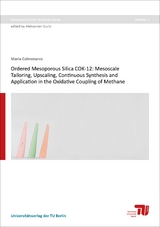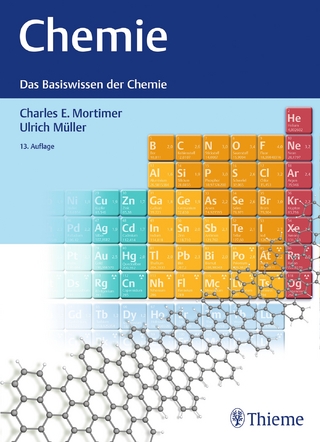Ordered mesoporous silica COK-12: mesoscale tailoring, upscaling, continuous synthesis and application in the oxidative coupling of Methane
Seiten
2018
Universitätsverlag der TU Berlin
978-3-7983-2988-1 (ISBN)
Universitätsverlag der TU Berlin
978-3-7983-2988-1 (ISBN)
- Keine Verlagsinformationen verfügbar
- Artikel merken
Ordered mesoporous silica (OMS) materials are a family of silica nanomaterials with pores ranging in size from 2 to 50 nm which are arranged periodically within the silica matrix. They have expanding applications in various fields of research, such as drug delivery, adsorption, separation and catalysis. COK-12 is an OMS produced by the soft-templating method, using the block copolymer P123 as a structure-directing agent. The synthesis takes place at room temperature under mild reaction conditions. In comparison with the most widely known OMS, the synthesis of COK-12 is more time efficient, inexpensive and environmentally friendly, yielding a material analogous to the well-known SBA-15.
This thesis encompasses investigations regarding the production of the ordered mesoporous silica material (OMS) known as COK-12, in terms of upscaling of the synthesis and tailoring of the size and shape of its characteristic hexagonal pore structure. Batch upscaling of the synthesis yielded a material with nearly identical properties to that of the original COK-12. Upscaling of the COK-12 synthesis was also studied in continuous mode. The installation and operation of a continuous COK-12 production unit was carried out with the aim to determine the possibility of large-scale production of COK-12 with consistent material properties. COK-12 was produced in continuous mode by varying the time of aging of the COK-12 slurry and the flow rate of the feed streams, yielding materials with properties nearly identical to those of the original COK-12.
COK-12 was used as a support for the Na2WO4-Mn/SiO2 catalyst for the oxidative coupling of methane reaction in various forms (powder, granular produced by pressing and monolithic), showing promising results comparable to the enhanced activity of the catalyst supported on the SBA-15. The advantage of using COK-12 over other OMS materials is that the facile nature of COK-12 synthesis makes it a viable candidate for industrial production of the Na2WO4-Mn/SiO2 catalyst, if paired with appropriate pelletizing and preparation method.
The introduction of hexane and polypropylene glycol (PPG) as micellar swelling agents into the original COK-12 synthesis was studied in order to tailor the mesoporous structure of the system. Hexane was used as a micelle expander and as an agent to produce silica mesocellular foams, with “ink-bottle” shaped pores with a larger diameter than that of the original COK-12. By adding PPG into the synthesis, the shift of the mesostructure of COK-12 from 2D hexagonal to a multilamellar vesicular configuration was studied, resulting in the progressive formation of this type of material with increasing concentration of PPG. The flexibility of the COK-12 synthesis in terms of upscaling and tailoring of the mesostructure was examined throughout this work, with an aim to contribute to the existing and expanding knowledge regarding more versatile, sustainable and possibly industrial OMS production. Ordered Mesoporous Silica (OMS) gehört zu der Familie der Silica-Nanomaterialien mit periodisch angeordneten Mesoporen im Größenbereich zwischen 2 und 50 nm. Diese werden zunehmend in unterschiedlichen Forschungsfeldern wie Medikamentenfreisetzung, Adsorption, Separation und Katalyse eingesetzt. COK-12 ist ein OMS, das über eine Soft-Templating-Methode unter Nutzung des Blockcopolymers P123 als strukturbestimmenden Zusatz erzeugt wird. Die Synthese erfolgt bei Raumtemperatur unter milden Reaktionsbedingungen. Im Vergleich zu den am weitesten bekannten OMS-Materialien ist die Synthese von COK-12 zeiteffizient, günstig und umweltfreundlich. Dabei wird ein OMS-Material analog zu dem bereits etablierten SBA-15 erzeugt. Die vorliegende Dissertation umfasst die Synthese eines als COK-12 bekannten OMS-Materials, dem Scale-Up der Synthese sowie die Anpassung und Modifizierung der ursprünglich hexagonal-angeordneten Mesoporen bezüglich Porengrößen und Porenform. Das diskontinuierliche Scale-Up im Batchprozess führt zu nahezu identischen Materialeigenschaften im Vergleich zu dem ursprünglichen COK-12. Ein Scale-Up der COK-12-Synthese wurde zusätzlich im kontinuierlichen Prozess erprobt. Dessen Installation und Operation wurde mit dem Ziel durchgeführt, um die Möglichkeit einer Produktion von großen Mengen an COK-12 mit einheitlichen Materialeigenschaften zu validieren. Durch eine Variation der Alterungszeit als auch der Fließrate der Lösungen konnte COK-12 im kontinuierlichen Prozess mit nahezu identischen Eigenschaften wie das ursprüngliche COK-12 erzeugt werden. COK-12 wurde erfolgreich in verschiedenen Formen (Pulver, Pressgranulate und Monolithe) als Trägermaterial für Na2WO4-Mn/SiO2-Katalysatoren für die Oxidative Kopplung von Methan eingesetzt. Die resultierenden Aktivitäten ist sind vergleichbar mit denen des auf SBA-15-geträgerten Katalysators Der Vorteil der Nutzung von COK-12 im Vergleich zu anderen OMS-Materialien liegt in der vergleichsweise simplen COK-12-Synthese, weshalb es ein interessanter Kandidat für eine mögliche industrielle Produktion des Na2WO4-Mn/SiO2-Katalysators ist, wenn geeignete Pelletierungs- und Herstellungsmethoden angewendet werden.
Die Zugabe von Hexan und Polypropylenglykol (PPG) zur Aufweitung der Mizellen in der ursprünglichen COK-12-Synthese wurde untersucht, um die mesoporöse Struktur des Systems zu variieren. Hexan wurde eingesetzt zur Aufweitung der Mizellen und als Hilfsmittel zur Produktion mesozellulärer Silica-Schäume mit „ink-bottle“-förmigen Poren sowie vergrößertem Porendurchmesser im Vergleich zu denen des ursprünglichen COK-12. Durch die Zugabe von PPG in die Synthese verändert sich die Mesoporenstruktur der ursprünglichen hexagonalen 2D-Struktur zu einer multilamellaren vesikulären Anordnung, die mit zunehmender PPG-Konzentration verstärkt wird.
Die Flexibilität der COK-12-Synthese wurde in dieser Arbeit in Bezug auf ein Scale-Up und eine Porenmodifikation weitreichend untersucht, mit dem Ziel das existierende Wissen in Bezug auf eine vielseitige, nachhaltige sowie eine potentielle Industrieproduktion der COK-12-Synthese zu entwickeln.
This thesis encompasses investigations regarding the production of the ordered mesoporous silica material (OMS) known as COK-12, in terms of upscaling of the synthesis and tailoring of the size and shape of its characteristic hexagonal pore structure. Batch upscaling of the synthesis yielded a material with nearly identical properties to that of the original COK-12. Upscaling of the COK-12 synthesis was also studied in continuous mode. The installation and operation of a continuous COK-12 production unit was carried out with the aim to determine the possibility of large-scale production of COK-12 with consistent material properties. COK-12 was produced in continuous mode by varying the time of aging of the COK-12 slurry and the flow rate of the feed streams, yielding materials with properties nearly identical to those of the original COK-12.
COK-12 was used as a support for the Na2WO4-Mn/SiO2 catalyst for the oxidative coupling of methane reaction in various forms (powder, granular produced by pressing and monolithic), showing promising results comparable to the enhanced activity of the catalyst supported on the SBA-15. The advantage of using COK-12 over other OMS materials is that the facile nature of COK-12 synthesis makes it a viable candidate for industrial production of the Na2WO4-Mn/SiO2 catalyst, if paired with appropriate pelletizing and preparation method.
The introduction of hexane and polypropylene glycol (PPG) as micellar swelling agents into the original COK-12 synthesis was studied in order to tailor the mesoporous structure of the system. Hexane was used as a micelle expander and as an agent to produce silica mesocellular foams, with “ink-bottle” shaped pores with a larger diameter than that of the original COK-12. By adding PPG into the synthesis, the shift of the mesostructure of COK-12 from 2D hexagonal to a multilamellar vesicular configuration was studied, resulting in the progressive formation of this type of material with increasing concentration of PPG. The flexibility of the COK-12 synthesis in terms of upscaling and tailoring of the mesostructure was examined throughout this work, with an aim to contribute to the existing and expanding knowledge regarding more versatile, sustainable and possibly industrial OMS production. Ordered Mesoporous Silica (OMS) gehört zu der Familie der Silica-Nanomaterialien mit periodisch angeordneten Mesoporen im Größenbereich zwischen 2 und 50 nm. Diese werden zunehmend in unterschiedlichen Forschungsfeldern wie Medikamentenfreisetzung, Adsorption, Separation und Katalyse eingesetzt. COK-12 ist ein OMS, das über eine Soft-Templating-Methode unter Nutzung des Blockcopolymers P123 als strukturbestimmenden Zusatz erzeugt wird. Die Synthese erfolgt bei Raumtemperatur unter milden Reaktionsbedingungen. Im Vergleich zu den am weitesten bekannten OMS-Materialien ist die Synthese von COK-12 zeiteffizient, günstig und umweltfreundlich. Dabei wird ein OMS-Material analog zu dem bereits etablierten SBA-15 erzeugt. Die vorliegende Dissertation umfasst die Synthese eines als COK-12 bekannten OMS-Materials, dem Scale-Up der Synthese sowie die Anpassung und Modifizierung der ursprünglich hexagonal-angeordneten Mesoporen bezüglich Porengrößen und Porenform. Das diskontinuierliche Scale-Up im Batchprozess führt zu nahezu identischen Materialeigenschaften im Vergleich zu dem ursprünglichen COK-12. Ein Scale-Up der COK-12-Synthese wurde zusätzlich im kontinuierlichen Prozess erprobt. Dessen Installation und Operation wurde mit dem Ziel durchgeführt, um die Möglichkeit einer Produktion von großen Mengen an COK-12 mit einheitlichen Materialeigenschaften zu validieren. Durch eine Variation der Alterungszeit als auch der Fließrate der Lösungen konnte COK-12 im kontinuierlichen Prozess mit nahezu identischen Eigenschaften wie das ursprüngliche COK-12 erzeugt werden. COK-12 wurde erfolgreich in verschiedenen Formen (Pulver, Pressgranulate und Monolithe) als Trägermaterial für Na2WO4-Mn/SiO2-Katalysatoren für die Oxidative Kopplung von Methan eingesetzt. Die resultierenden Aktivitäten ist sind vergleichbar mit denen des auf SBA-15-geträgerten Katalysators Der Vorteil der Nutzung von COK-12 im Vergleich zu anderen OMS-Materialien liegt in der vergleichsweise simplen COK-12-Synthese, weshalb es ein interessanter Kandidat für eine mögliche industrielle Produktion des Na2WO4-Mn/SiO2-Katalysators ist, wenn geeignete Pelletierungs- und Herstellungsmethoden angewendet werden.
Die Zugabe von Hexan und Polypropylenglykol (PPG) zur Aufweitung der Mizellen in der ursprünglichen COK-12-Synthese wurde untersucht, um die mesoporöse Struktur des Systems zu variieren. Hexan wurde eingesetzt zur Aufweitung der Mizellen und als Hilfsmittel zur Produktion mesozellulärer Silica-Schäume mit „ink-bottle“-förmigen Poren sowie vergrößertem Porendurchmesser im Vergleich zu denen des ursprünglichen COK-12. Durch die Zugabe von PPG in die Synthese verändert sich die Mesoporenstruktur der ursprünglichen hexagonalen 2D-Struktur zu einer multilamellaren vesikulären Anordnung, die mit zunehmender PPG-Konzentration verstärkt wird.
Die Flexibilität der COK-12-Synthese wurde in dieser Arbeit in Bezug auf ein Scale-Up und eine Porenmodifikation weitreichend untersucht, mit dem Ziel das existierende Wissen in Bezug auf eine vielseitige, nachhaltige sowie eine potentielle Industrieproduktion der COK-12-Synthese zu entwickeln.
| Erscheinungsdatum | 14.07.2018 |
|---|---|
| Reihe/Serie | Advanced Ceramic Materials ; 1 |
| Verlagsort | Berlin |
| Sprache | englisch |
| Maße | 148 x 210 mm |
| Gewicht | 340 g |
| Themenwelt | Naturwissenschaften ► Chemie ► Organische Chemie |
| Naturwissenschaften ► Chemie ► Physikalische Chemie | |
| Technik ► Maschinenbau | |
| Schlagworte | continuous synthesis • Heterogene Katalyse • Heterogeneous catalysis • kontinuierliche Synthese • mesoscale tailoring • ordered mesoporous silica • Porenmodifikation • Scale-up |
| ISBN-10 | 3-7983-2988-5 / 3798329885 |
| ISBN-13 | 978-3-7983-2988-1 / 9783798329881 |
| Zustand | Neuware |
| Haben Sie eine Frage zum Produkt? |
Mehr entdecken
aus dem Bereich
aus dem Bereich




